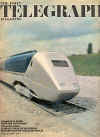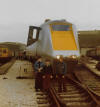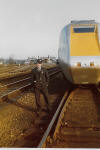|

|
A general view of the Control Centre and workshop, nearing completion in March 1970. The site had yet to have its security fence erected. Note the MR goods shed in the right background.
Author's collection
|

|
A closer view of the Control Centre and the workshop
Author's collection
|

|
Another view of the workshop showing the access pit. It was equipped with an overhead crane and a wheel drop facility too but was very short and could barely hold a coach without the doors being left open. The author well remembers the cold windy Winter's days spent working on rolling stock here.
Author's collection |
 |
The Research Division, Clayton Class 17 loco No: 8512 sets off for Asfordby from the north end of the test track on 14th October 1971. Just visible through the open frames of the POP train's skeletal wagons are the houses of Tollerton on the A606 Nottingham to Melton road.
Not long after this photo was taken the loco suffered a major failure and
was replaced with 8598
Jack Hooke |
|
 |
This is another view of the POP
train shown in the previous picture
Jack Hooke
|

|
Clayton bo-bo locomotive No: 8512 pictured with the POP train standing in the former Down platform at Widmerpool Station, facing south
in summer 1971. Perhaps the train crew had nipped in to the Schooner Inn, which occupied the former Up platform buildings at the time, for a cuppa.
Alan Rimmer
|

|
POP train passes the end of the access line to the test track at Melton Jcn.
having come from the RTC en route for Old Dalby in early 1973
Author's
collection |
 |
POP train on the Widmerpool straight near the A46
Unknown |

|
Meanwhile the APT-E was taking shape and is pictured here undergoing end-loading
tests in the R&DD workshop
Colin Marsden
|

|
In this shot two of the vehicles are being fitted out as test cars
Colin
Marsden |
 |
One of the trailer car bodyshells pictured in the
Vehicles Lab at the RTC on 16th March 1971 when undergoing structural - note the
cables from the various strain-gauges attached to the bodyshell. Author's collection |

|
One of the driving car bodies pictured in the Vehicles Lab
at the RTC on 8th July 1971 when undergoing structural testing This part of the RTC
is now RVEL's maintenance workshop.
Author's collection
|
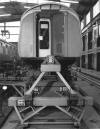 |
Another view of the structural tests - note POP
train on the next road Author's collection |
 |
APT-E pictured in the Vehicles Lab workshop at the RTC in the company of one of the power cars of the prototype HST then identified as class 252 001 -
October 1974
Author's Collection
|
 |
APT-E at the Mickleover test track in the early 1970s
Gerald Anthony |
 |
Heading north on the Midland
main line near Loughborough
J A Lower |

|
APT-E sits on the Goods Road at Derby Station prior to its first run to Duffield, 5 miles to the north,
on July 25th 1972.
Author's collection
|
 |
By September 1973 APT-E paid its
first visit to Old Dalby and is pictured here outside the Control Centre
Author's Collection
|
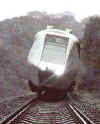 |
A head-on view in the vicinity
of MP111 at the north end of Grimston Tunnel
Author's collection |

|
Another shot on the test track. I'm not sure exactly where this was taken
but it may be the southern side of Stanton Tunnel
Cecil J Allen collection |
 |
The cab layout was designed
around a central seating position.
Author's collection |

|
The articulation between the
vehicles
Author's collection
|
 |
APT-E flashes past MP 111, just north of Grimston Tunnel, on a northbound high speed test run.
Author's collection
|
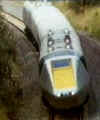
|
APT-E rounds the curve at Upper Broughton on a southbound run
A still from
the BT Films 'E for Experimental'
|

|
APT-E running north into Upper Broughton curve at
speed with TC2 in tilt failure mode in August 1974. This meant that the car was
tilted 6º from the centre line in the opposite direction from the rest of the
train.
Author's Collection
|

|
Another shot from August 1974 shows the train
running south at Upper Broughton. During these tests speeds of up to 125
mile/h were attained with simulated tilt failure.
Author's Collection |

|
Here it is at the south end of Saxelby Tunnel where
several experimental switches and crossings were installed.
Author's
collection |

|
Another shot at the north end of Grimston Tunnel
shows the immense overhang of the cab on APT-E
Author's collection |

|
In order to traverse the curve at Upper Broughton at high speed, the cant was raised to a value of 7 inches (178 mm) during the ATP-E test programme.
The normal speed of the curve was then limited to around 75 mile/h.
Author's collection
|

|
In June 1974 the APT-E
takes the curve at London Road Junction on the way to Old Dalby.
|

|
On 27th February
1976, just one month after attaining nearly 144 mile/h at Old Dalby, APT-E
stands at Kettering Station after a high speed dash down the Midland
main line from Derby. The occasion was a special run from Derby conveying
staff from the RTC on a jolly.
|

|
Later the train was stabled in the Down Goods road awaiting a return path home
On the next road is one of the ubiquitous 16T mineral wagons, which in a lot of people's eyes represented the old railway.
|

|
Staff from the Railway Technical Centre admire the sleek lines of the
APT-E whilst it waits in Kettering Down platform ready for the return run |
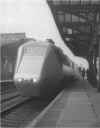
|
The train crew are aboard and all ready for the off and a quick belt down the Midland back to Derby
|
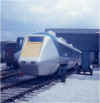 |
Back home in the Research Division yard outside the Test Hall 'E-Train', as it was more commonly known, rests in the sunshine
Mick Wright |

|
'E-Train' manoeuvres on the loop at the RTC sidings in June 1974 prior to departing for Old Dalby.
|
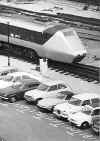 |
APT-E in the sidings at the Railway Technical Centre in 1975 prior to a trip to Old Dalby. The Triumph Spitfire was owned by the author at the time.
|

|
In this overall view from the top of Brunel House, the APT-E can be seen leaving Derby en route to the test track in June 1974. There's a wealth of detail in the background of this picture - now mostly gone
|
 |
APT-E gets
some attention in the sidings at the RTC in the summer of 1974 between trips to
the test track
|
 |
Here is the Mercedes Benz 'Unimog'
road/rail vehicle which was used at RTC and Old Dalby pictured in the
sidings with E Train behind it
Colin Marsden |
 |
APT-E pictured in the loop at
the top of the RTC site
BR Official |
 |
An unusual official picture of
E-train in the RTC yard outside the EDU
BR Official
|
 |
Another similar shot with the
Vehicles Lab in the background
BR Official |
 |
And one of the power car - note
the lamp bracket
BR Official |
 |
In this first of two general views of the RTC yard in June 1974 the APT-E can be seen sticking out of the Vehicles Lab workshop. Also in the shot is part of the 'POP' train, one of the prototype HST power cars,
HSFV1, the Battery Railcar and the Elliott 4-wheel Track Recording Car - Lab
20.
|

|
In this second general view of the RTC yard in June 1974 the APT-E can be seen on the right next to the Research Division's 'Baby
Deltic' loco. In the centre is the first of the recently re-furbished and re-liveried Class 101/2 DMU's for West Midlands PTE, a short-lived idea.
|

|
During its trials at Old Dalby 'E-Train' often ran as a three car set
and here it is passing the EDU en route to the test track sometime in 1974
Mick
Wright |

|
Moments later it's past and away towards Trent Junction and on to Old Dalby
Mick Wright |
|
 |
APT-E pictured on the Goods Road at
Derby in September 1974
Ian Walmsley |
 |
APT-E passes Steventon on 27th July
1975 whilst on a test run
D E Canning |
 |
APT-E near Goring on 27th July 1975
whilst on a test run
D E Canning |
 |
On 28th October 1975 APT-E is
pictured arriving at St Pancras during a series of test runs on the Midland line
BR Official |
 |
APT-E waiting to depart from St
Pancras for the run back to the RTC
BR Official |
 |
A cut-away model of the Hydrokinetic brake as fitted
to APT-E in the Stores at the NRM York |

